
Tony Breu
@tonybreu.bsky.social
Hospitalist, VA Boston Healthcare System. Co-host, Curious Clinicians Podcast
Reposted by Tony Breu
Glucose IS an effective osmole in the absence of insulin or insulin resistance. So hyperglycemia does lead to polydipsia (and polyuria due to osmotic diuresis)
November 28, 2024 at 12:42 PM
Glucose IS an effective osmole in the absence of insulin or insulin resistance. So hyperglycemia does lead to polydipsia (and polyuria due to osmotic diuresis)
9/9
💧 An increase in effective osmoles (e.g., sodium) produces thirst via the movement of water out of cells (i.e., intracellular dehydration)
💧Urea and other ineffective osmoles don't produce the same shifts and, therefore, lead to less thirst
💧 An increase in effective osmoles (e.g., sodium) produces thirst via the movement of water out of cells (i.e., intracellular dehydration)
💧Urea and other ineffective osmoles don't produce the same shifts and, therefore, lead to less thirst
November 28, 2024 at 2:41 AM
9/9
💧 An increase in effective osmoles (e.g., sodium) produces thirst via the movement of water out of cells (i.e., intracellular dehydration)
💧Urea and other ineffective osmoles don't produce the same shifts and, therefore, lead to less thirst
💧 An increase in effective osmoles (e.g., sodium) produces thirst via the movement of water out of cells (i.e., intracellular dehydration)
💧Urea and other ineffective osmoles don't produce the same shifts and, therefore, lead to less thirst
8/
The mechanism described above helps explain why other ineffective osmoles that increase serum osmolarity (e.g., glucose) are not independent drivers of thirst.
t.ly/odecD
The mechanism described above helps explain why other ineffective osmoles that increase serum osmolarity (e.g., glucose) are not independent drivers of thirst.
t.ly/odecD
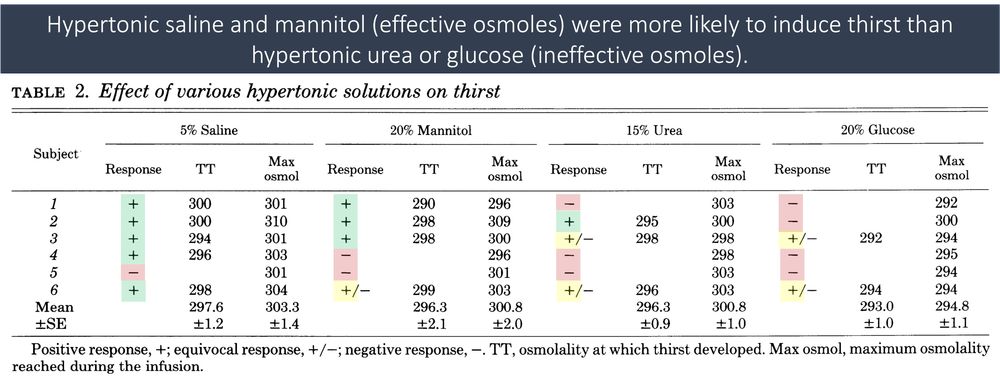
November 28, 2024 at 2:41 AM
8/
The mechanism described above helps explain why other ineffective osmoles that increase serum osmolarity (e.g., glucose) are not independent drivers of thirst.
t.ly/odecD
The mechanism described above helps explain why other ineffective osmoles that increase serum osmolarity (e.g., glucose) are not independent drivers of thirst.
t.ly/odecD
7/
The explanation above leads to a beautiful symmetry of thirst promoters.
Either...
➤EXTRAcellular volume depletion
...or...
➤INTRAcellular volume depletion...
...will make you seek water.
The explanation above leads to a beautiful symmetry of thirst promoters.
Either...
➤EXTRAcellular volume depletion
...or...
➤INTRAcellular volume depletion...
...will make you seek water.
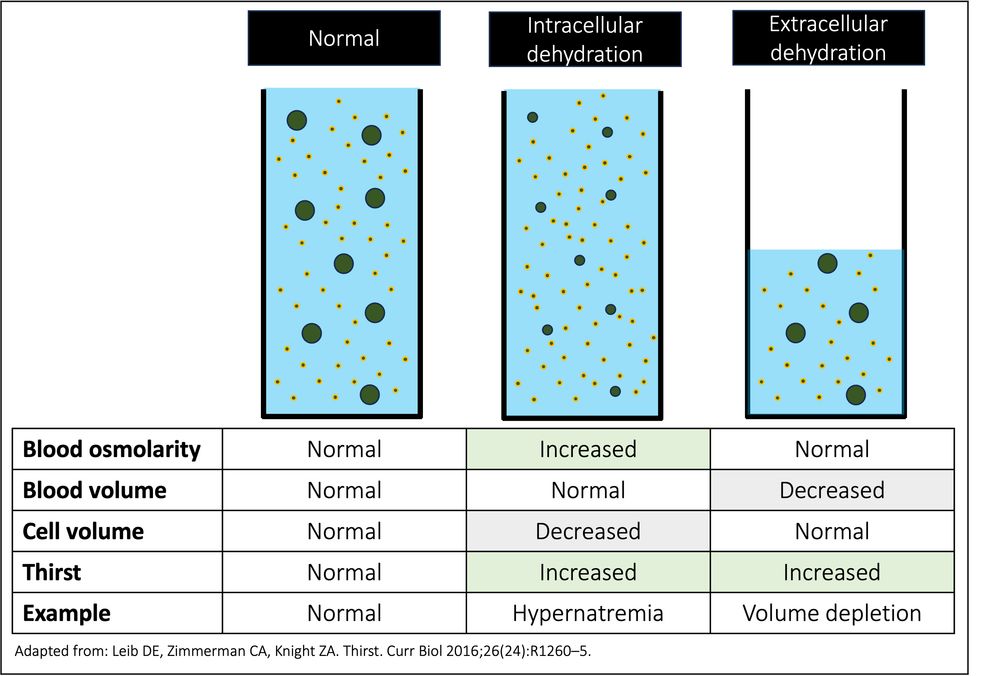
November 28, 2024 at 2:41 AM
7/
The explanation above leads to a beautiful symmetry of thirst promoters.
Either...
➤EXTRAcellular volume depletion
...or...
➤INTRAcellular volume depletion...
...will make you seek water.
The explanation above leads to a beautiful symmetry of thirst promoters.
Either...
➤EXTRAcellular volume depletion
...or...
➤INTRAcellular volume depletion...
...will make you seek water.
6/
What is the "sensor" for cellular dehydration?
It appears that transient receptor potential vanilloid 1 (TRPV1) is key. TRPV1 is a non-selective cation channel that detects harmful stimuli like heat and capsaicin.
💡 It is also activated by cell shrinking!
t.ly/lqhvy
What is the "sensor" for cellular dehydration?
It appears that transient receptor potential vanilloid 1 (TRPV1) is key. TRPV1 is a non-selective cation channel that detects harmful stimuli like heat and capsaicin.
💡 It is also activated by cell shrinking!
t.ly/lqhvy
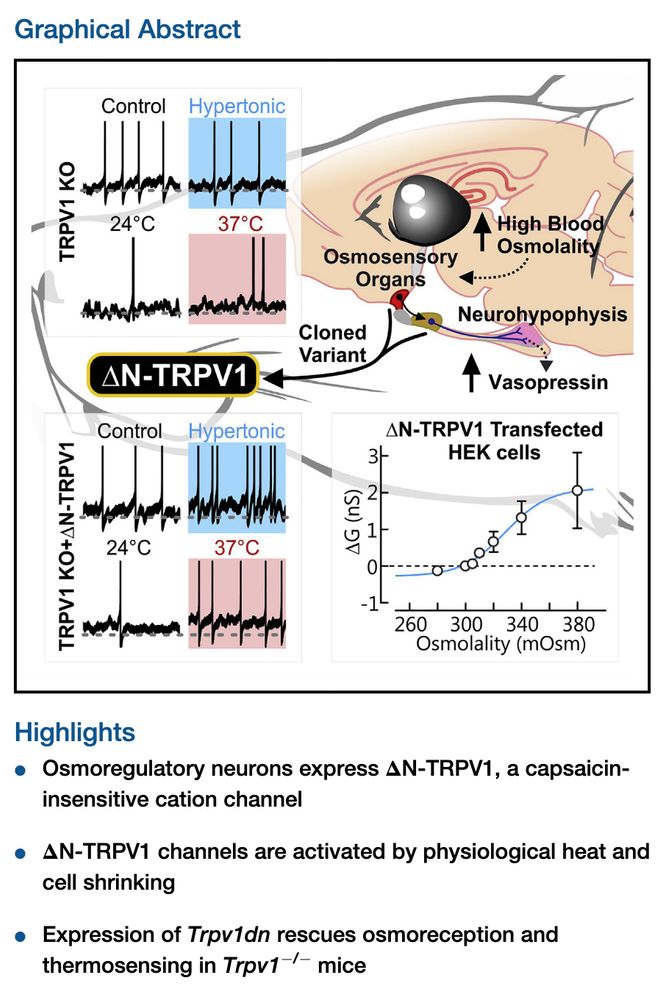
November 28, 2024 at 2:41 AM
6/
What is the "sensor" for cellular dehydration?
It appears that transient receptor potential vanilloid 1 (TRPV1) is key. TRPV1 is a non-selective cation channel that detects harmful stimuli like heat and capsaicin.
💡 It is also activated by cell shrinking!
t.ly/lqhvy
What is the "sensor" for cellular dehydration?
It appears that transient receptor potential vanilloid 1 (TRPV1) is key. TRPV1 is a non-selective cation channel that detects harmful stimuli like heat and capsaicin.
💡 It is also activated by cell shrinking!
t.ly/lqhvy
5/
Based on this experiment, Gilman concluded that it is INTRAcellular dehydration that leads to thirst.
This results from a hypertonic extracellular space (e.g., hypernatremia) and the movement of water outside of cells.
t.ly/It2oB
Based on this experiment, Gilman concluded that it is INTRAcellular dehydration that leads to thirst.
This results from a hypertonic extracellular space (e.g., hypernatremia) and the movement of water outside of cells.
t.ly/It2oB

November 28, 2024 at 2:41 AM
5/
Based on this experiment, Gilman concluded that it is INTRAcellular dehydration that leads to thirst.
This results from a hypertonic extracellular space (e.g., hypernatremia) and the movement of water outside of cells.
t.ly/It2oB
Based on this experiment, Gilman concluded that it is INTRAcellular dehydration that leads to thirst.
This results from a hypertonic extracellular space (e.g., hypernatremia) and the movement of water outside of cells.
t.ly/It2oB
4/
Gilman then made another crucial observation:
💡Only NaCl led to a reduction in serum specific gravity. This suggested a shift of water from the intracellular to the extracellular space.
This only occurs with an effective osmole (e.g., sodium) and not an ineffective osmole (e.g., urea).
Gilman then made another crucial observation:
💡Only NaCl led to a reduction in serum specific gravity. This suggested a shift of water from the intracellular to the extracellular space.
This only occurs with an effective osmole (e.g., sodium) and not an ineffective osmole (e.g., urea).
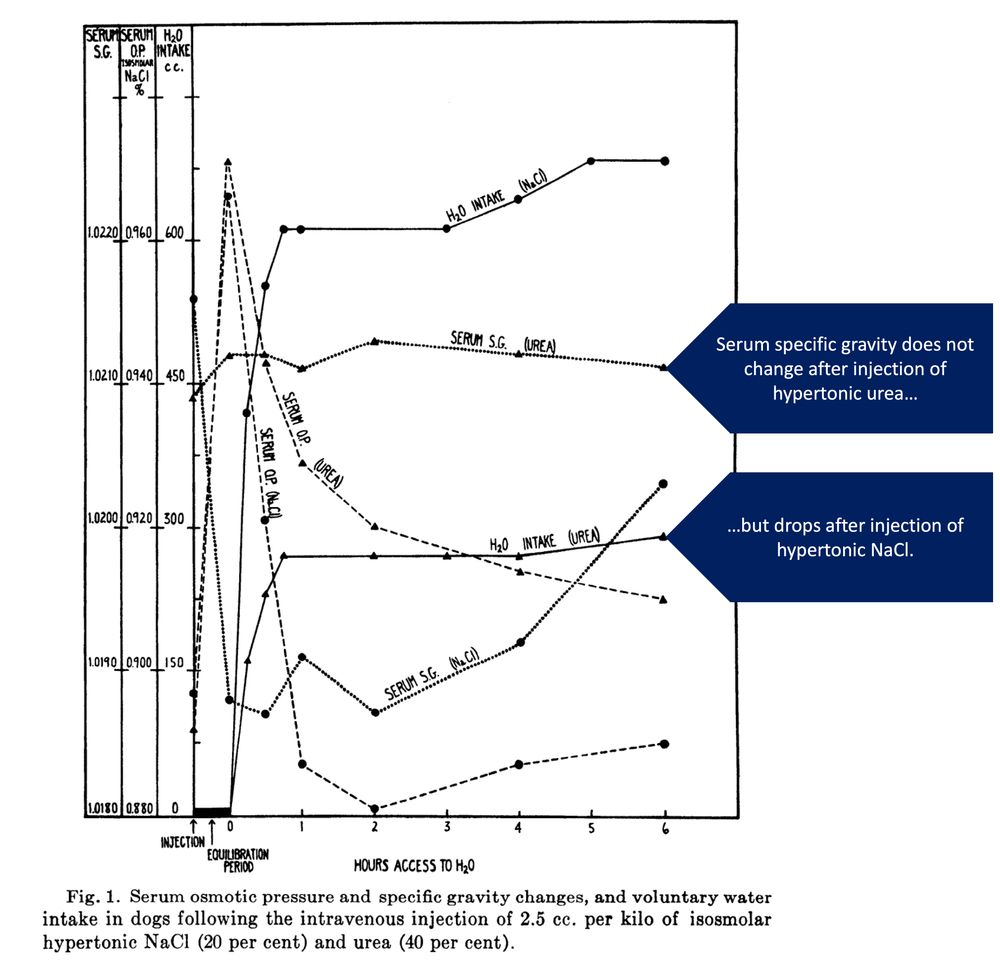
November 28, 2024 at 2:41 AM
4/
Gilman then made another crucial observation:
💡Only NaCl led to a reduction in serum specific gravity. This suggested a shift of water from the intracellular to the extracellular space.
This only occurs with an effective osmole (e.g., sodium) and not an ineffective osmole (e.g., urea).
Gilman then made another crucial observation:
💡Only NaCl led to a reduction in serum specific gravity. This suggested a shift of water from the intracellular to the extracellular space.
This only occurs with an effective osmole (e.g., sodium) and not an ineffective osmole (e.g., urea).
3/
After 30 minutes, the dogs were offered water, and had blood work drawn. Gilman made two key observations:
🔑 The increase in serum osmolarity with hypertonic NaCl and urea were nearly identical
🔑 Dogs drank significantly more water after hypertonic NaCl injection
t.ly/MIdqH
After 30 minutes, the dogs were offered water, and had blood work drawn. Gilman made two key observations:
🔑 The increase in serum osmolarity with hypertonic NaCl and urea were nearly identical
🔑 Dogs drank significantly more water after hypertonic NaCl injection
t.ly/MIdqH

November 28, 2024 at 2:41 AM
3/
After 30 minutes, the dogs were offered water, and had blood work drawn. Gilman made two key observations:
🔑 The increase in serum osmolarity with hypertonic NaCl and urea were nearly identical
🔑 Dogs drank significantly more water after hypertonic NaCl injection
t.ly/MIdqH
After 30 minutes, the dogs were offered water, and had blood work drawn. Gilman made two key observations:
🔑 The increase in serum osmolarity with hypertonic NaCl and urea were nearly identical
🔑 Dogs drank significantly more water after hypertonic NaCl injection
t.ly/MIdqH
2/
We've known for nearly a century that an increase in serum urea is not a significant driver of thirst.
In 1937, Alfred Gilman published an experiment in which dogs received an IV injection of either:
➤20% NaCl
➤40% urea
Both are hypertonic solutions.
t.ly/MIdqH
We've known for nearly a century that an increase in serum urea is not a significant driver of thirst.
In 1937, Alfred Gilman published an experiment in which dogs received an IV injection of either:
➤20% NaCl
➤40% urea
Both are hypertonic solutions.
t.ly/MIdqH

November 28, 2024 at 2:40 AM
2/
We've known for nearly a century that an increase in serum urea is not a significant driver of thirst.
In 1937, Alfred Gilman published an experiment in which dogs received an IV injection of either:
➤20% NaCl
➤40% urea
Both are hypertonic solutions.
t.ly/MIdqH
We've known for nearly a century that an increase in serum urea is not a significant driver of thirst.
In 1937, Alfred Gilman published an experiment in which dogs received an IV injection of either:
➤20% NaCl
➤40% urea
Both are hypertonic solutions.
t.ly/MIdqH
I used @en.blueark.app to transfer tweetorials previously posted on Twitter here to @bsky.app. Very fair price and quick process.
If you do the same, note my previous comments, particularly regarding links and search.
If you do the same, note my previous comments, particularly regarding links and search.
A few observations on BlueSky, after a week of use:
☞REPOSTS v LIKES: I don't see what others like, so reposts seem more powerful
☞LINKS: These consume the number of characters in the link, not a set amount (like Twitter)
☞SEARCH: I'm underwhelmed. It doesn't consistently result posts I know exist
☞REPOSTS v LIKES: I don't see what others like, so reposts seem more powerful
☞LINKS: These consume the number of characters in the link, not a set amount (like Twitter)
☞SEARCH: I'm underwhelmed. It doesn't consistently result posts I know exist
November 23, 2024 at 3:18 PM
I agree. Similarly, "tweetorial" can be applied to any set of threaded posts, no matter the site.
It's not too dissimilar to a Band-Aid. My kids call all adhesive bandages Band-Aids, even those not made by J&J.
It's not too dissimilar to a Band-Aid. My kids call all adhesive bandages Band-Aids, even those not made by J&J.
November 22, 2024 at 7:29 PM
I agree. Similarly, "tweetorial" can be applied to any set of threaded posts, no matter the site.
It's not too dissimilar to a Band-Aid. My kids call all adhesive bandages Band-Aids, even those not made by J&J.
It's not too dissimilar to a Band-Aid. My kids call all adhesive bandages Band-Aids, even those not made by J&J.
It's already here!
What's cool is that it's got the original date I posted it too! This is thanks to @en.blueark.app
bsky.app/profile/tony...
What's cool is that it's got the original date I posted it too! This is thanks to @en.blueark.app
bsky.app/profile/tony...
1/
Why does acute pulmonary embolism (PE) cause hypoxia?
It took me a while to realize I didn't have a good answer. Think about it: the blood upstream of the clot should be fully oxygenated. Where is the blood that isn't being oxygenated?
The answer is pretty cool...
Why does acute pulmonary embolism (PE) cause hypoxia?
It took me a while to realize I didn't have a good answer. Think about it: the blood upstream of the clot should be fully oxygenated. Where is the blood that isn't being oxygenated?
The answer is pretty cool...

November 22, 2024 at 3:53 PM
It's already here!
What's cool is that it's got the original date I posted it too! This is thanks to @en.blueark.app
bsky.app/profile/tony...
What's cool is that it's got the original date I posted it too! This is thanks to @en.blueark.app
bsky.app/profile/tony...
I did the same.
Not expensive and provides me a way to reference "old work." The only issue has been splitting tweets into two posts when I have a long URL (BlueSky doesn't have a set character allocation for links).
Not expensive and provides me a way to reference "old work." The only issue has been splitting tweets into two posts when I have a long URL (BlueSky doesn't have a set character allocation for links).
November 21, 2024 at 11:43 PM
I did the same.
Not expensive and provides me a way to reference "old work." The only issue has been splitting tweets into two posts when I have a long URL (BlueSky doesn't have a set character allocation for links).
Not expensive and provides me a way to reference "old work." The only issue has been splitting tweets into two posts when I have a long URL (BlueSky doesn't have a set character allocation for links).
There appears to be some association (pubmed.ncbi.nlm.nih.gov/25270263/) though in a phase 2 trial the primary end point was not met (pubmed.ncbi.nlm.nih.gov/33754202/).
It seems like an RCT is complete though no results reported (clinicaltrials.gov/study/NCT050...)
It seems like an RCT is complete though no results reported (clinicaltrials.gov/study/NCT050...)

Interleukin-31 is associated with uremic pruritus in patients receiving hemodialysis - PubMed
IL-31 may play an important role in the pathophysiology of uremic pruritus.
pubmed.ncbi.nlm.nih.gov
November 20, 2024 at 1:57 AM
There appears to be some association (pubmed.ncbi.nlm.nih.gov/25270263/) though in a phase 2 trial the primary end point was not met (pubmed.ncbi.nlm.nih.gov/33754202/).
It seems like an RCT is complete though no results reported (clinicaltrials.gov/study/NCT050...)
It seems like an RCT is complete though no results reported (clinicaltrials.gov/study/NCT050...)
4/4
It will be interesting to see if nemolizumab, an interleukin-31 receptor alpha antagonist, helps mitigate lymphoma-associated pruritus in the rare case when it becomes refractory.
This drug has been tested in atopic dermatitis with pruritus and was effective.
t.ly/-i6US
It will be interesting to see if nemolizumab, an interleukin-31 receptor alpha antagonist, helps mitigate lymphoma-associated pruritus in the rare case when it becomes refractory.
This drug has been tested in atopic dermatitis with pruritus and was effective.
t.ly/-i6US

November 19, 2024 at 4:10 PM
4/4
It will be interesting to see if nemolizumab, an interleukin-31 receptor alpha antagonist, helps mitigate lymphoma-associated pruritus in the rare case when it becomes refractory.
This drug has been tested in atopic dermatitis with pruritus and was effective.
t.ly/-i6US
It will be interesting to see if nemolizumab, an interleukin-31 receptor alpha antagonist, helps mitigate lymphoma-associated pruritus in the rare case when it becomes refractory.
This drug has been tested in atopic dermatitis with pruritus and was effective.
t.ly/-i6US
3/
The mechanism involves a cytokine unfamiliar to me: IL-31.
In one study of HL and angioimmunoblastic T-cell lymphoma, those with pruritis had higher serum levels of IL-31, IL-1β, and IL-1α than those with lymphoma and no pruritis compared with controls.
t.ly/KxLw9
The mechanism involves a cytokine unfamiliar to me: IL-31.
In one study of HL and angioimmunoblastic T-cell lymphoma, those with pruritis had higher serum levels of IL-31, IL-1β, and IL-1α than those with lymphoma and no pruritis compared with controls.
t.ly/KxLw9
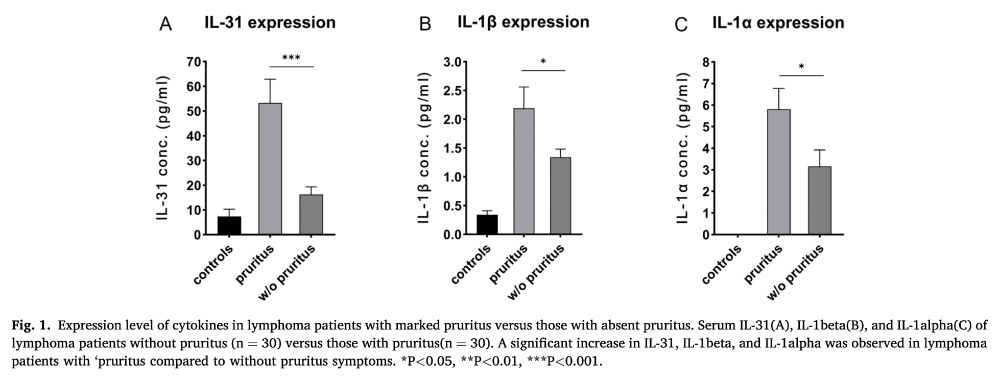
November 19, 2024 at 4:10 PM
3/
The mechanism involves a cytokine unfamiliar to me: IL-31.
In one study of HL and angioimmunoblastic T-cell lymphoma, those with pruritis had higher serum levels of IL-31, IL-1β, and IL-1α than those with lymphoma and no pruritis compared with controls.
t.ly/KxLw9
The mechanism involves a cytokine unfamiliar to me: IL-31.
In one study of HL and angioimmunoblastic T-cell lymphoma, those with pruritis had higher serum levels of IL-31, IL-1β, and IL-1α than those with lymphoma and no pruritis compared with controls.
t.ly/KxLw9
2/
The association between HL (and other lymphomas) and pruritus has prompted many to recommend a chest x-ray as part of the initial work-up when a primary skin disorder isn't present.
A 2013 NEJM review suggests this, as does Up-To-Date.
t.ly/wB5Xv
The association between HL (and other lymphomas) and pruritus has prompted many to recommend a chest x-ray as part of the initial work-up when a primary skin disorder isn't present.
A 2013 NEJM review suggests this, as does Up-To-Date.
t.ly/wB5Xv
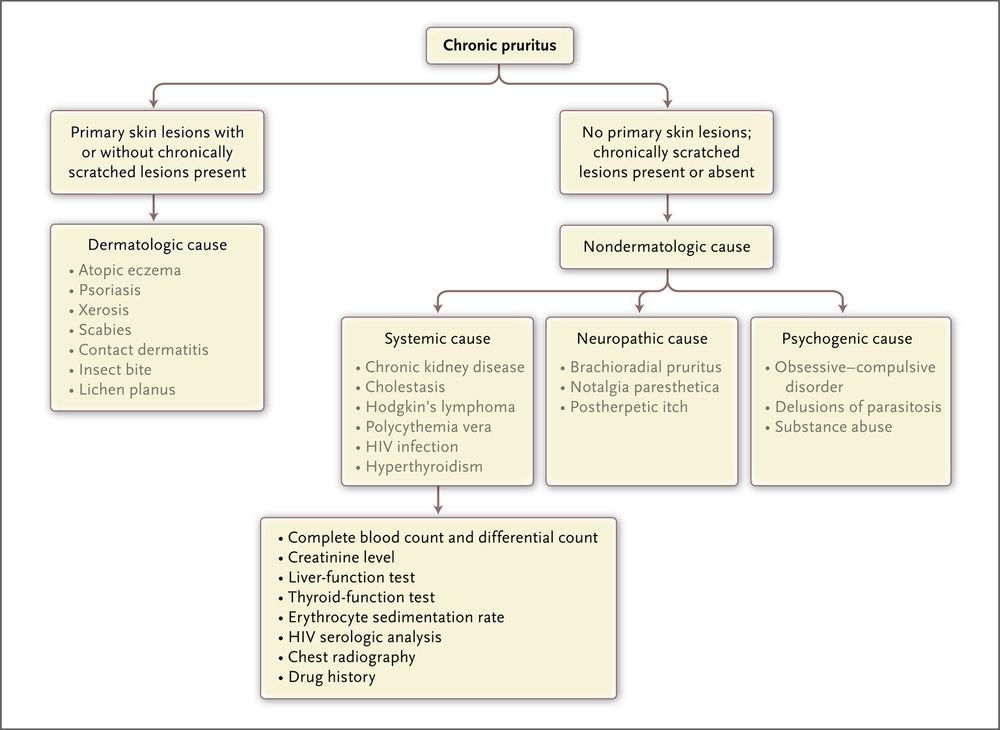

November 19, 2024 at 4:10 PM
2/
The association between HL (and other lymphomas) and pruritus has prompted many to recommend a chest x-ray as part of the initial work-up when a primary skin disorder isn't present.
A 2013 NEJM review suggests this, as does Up-To-Date.
t.ly/wB5Xv
The association between HL (and other lymphomas) and pruritus has prompted many to recommend a chest x-ray as part of the initial work-up when a primary skin disorder isn't present.
A 2013 NEJM review suggests this, as does Up-To-Date.
t.ly/wB5Xv

